There are several challenges associated with rapid manufacturing. One of the major ones is ensuring the movement of products to market as fast as possible. At the same time, you need to ensure that your product remains at the highest standards. This gave rise to the need for rapid injection molding.
Initially, manufacturers associated this term with mass production and large capital investments. They ignore it as an ideal method for producing complex plastic parts. However, improvements in prototyping technologies have put rapid injection molding among the foremost techniques in prototyping.
What is Rapid Injection Molding?
Rapid injection molding (RIM) is very similar to the conventional type. However, it is a much faster version. This process aims to act as a bridge to production for making prototype parts.
RIM uses CAD designs and cost-effective tooling to enable engineers to create top-quality production molds. When combined with plastic resins, these molds make parts that meet clients’ needs. The major differences between RIM and conventional injection molding are in the manufacturing of their tooling.
Conventional injection molding aims to make highly durable molds. Therefore, the molds are made from hardened steel, which is a real challenge for the machine. On the other hand, rapid injection molding uses softer materials. This is because it is used for low volume injection molding and smaller runs.
In this case, using aircraft-grade aluminum alloys is a great option because they are easier to machine despite their high strength. Thus, manufacturers cut up to 30% of tooling time and up to 5 times in post-processing. It also translates to less time for designing, manufacturing, and fine-tuning tooling.
Furthermore, you can redesign dies for rapid injection molding more easily. Manufacturing the cavity and the die base is separate for this process to ensure better flexibility. This way, you can remove the cavity whenever you need to adjust the tooling while leaving the other parts untouched.
In all, rapid injection molding seeks to cut prototyping time without compromising quality. This way, clients can get parts within 3-5 weeks instead of the 3-5 months associated with conventional injection molding.
Advantages of Rapid Injection Molding for Low Volume Manufacturing
Rapid injection molding offers several benefits to the manufacturing space. From design to cost analysis, there’s no limit to what you can get.
Here, we’ll discuss some of the advantages of rapid injection molding.
Consistent Part Design
Tool design is the first step in every injection molding process. At the beginning of tool design, a part’s formation must have been conceptualized. Therefore, there is, at least, a theoretical idea of the looks and functions of the part. Rapid injection molding breaks down big and intricate parts into smaller and less intricate ones.
Thanks to the more robust and easier creation of mold cavities, you can produce complex parts with intricate features easily. Also, rapid injection molding offers incredible uniformity to give you the chance to create thousands of identical parts. RIM creates a bridge to mass production with some modifications in design and tooling materials.
Faster Lead Time
Developers and engineers often enjoy the quick processing that comes with rapid injection molding. Starting with the process of making molds down to the cycle time used for each batch, you can take advantage of faster manufacturing.
Since RIM involves the use of aluminum alloys, machining becomes easier, and parts are often ready within days or weeks as compared to months for conventional injection molding. Rapid injection molding removes the time required to make mold patterns and other specialized tools. Therefore, it removes the time between analysis and design to create an appropriate model for performance testing.
Low Labor Requirement
As mentioned earlier, rapid injection molding does not require any complex process due to its reduced requirements. A few molding batches attached to a single CNC machining process can perform RIM. The quick processing does not require too much supervision to get the desired output.
Therefore, there’s offer little to no need for a large workforce because RIM is not labor-intensive. This is also due, partly, to the automation of some of its processes. Thus, you can be certain of reduced labor costs when it comes to rapid injection molding.
Low Material Waste
Many prototyping processes do not consider materials at all. That may be acceptable during the manufacture of single-digit batches. However, extensive testing in live conditions is important for some products. An instance is with medical prototypes with their last testing stage at the consumer level. In such cases, you will need thousands of samples.
Therefore, it will not be a good idea to lose 50% of blank materials because it will cost a considerable sum. Rapid injection molding works by injecting just the right amount of plastic resins into the cavity. This way, it minimizes the waste on materials. One the sprue, gates, runners, and flash in RIM generate resin waste. You can even decide to reuse or recycle the aluminum tooling after use.
Low Production Cost
In general, rapid injection molding reduces production costs. The popular belief is that reduced lead time translates to increased production costs. However, this is not the case for rapid injection molding. When you look at the advantages given above, you will agree that RIM comes with lower costs.
For instance, it requires lesser labor which means that labor costs will be reduced. Furthermore, materials for production are lesser for rapid injection molding. There is also a low material waste, with the mold tooling being easier to machine. All these, and many more, contribute to the lower production cost of rapid injection molding.
Final Thoughts
Rapid injection molding has several important optimization considerations that you must note to ensure quality and consistency. If properly done, RIM is a robust process with several advantages for designers, engineers, and manufacturers alike. It shortens lead time and reduces material waste significantly. Its benefits translate to low production costs and high-quality, consistent part development.









Add Comment